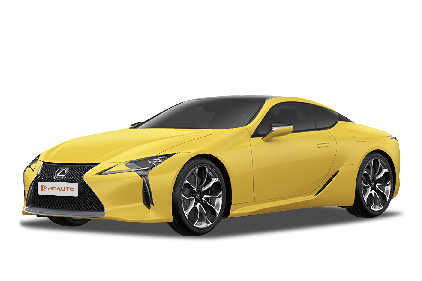Q
Is Lexus LC an electrical vehicle?
No, Lexus LC isn't an electric vehicle. Lexus LC 500 has 2018 and 2020 models and runs on gasoline. The 2018 model is equipped with a 5.0-liter naturally aspirated V8 engine with a maximum power of 477 horsepower. The 2020 model also features a 5.0-liter naturally aspirated V8 engine with the same power of 477 horsepower. These models rely on internal combustion engines for power. There are different types of electric vehicles in the market, such as pure electric vehicles powered just by batteries and hybrid vehicles that combine a traditional engine with an electric motor. However, the Lexus LC 500 models clearly fall into the gasoline-powered category. It is equipped with a gasoline tank and a traditional internal combustion engine device to power the vehicle.
Special Disclaimer: This content is published by users and does not represent the views or position of PCauto.
Related Q&A
Q
How does the 2018 LC 500 compare to the 2019?
The 2018 and 2019 Lexus LC 500 don't differ much in core design and performance. Both pack a 5.0-liter naturally aspirated V8 engine pumping out 477 horsepower, mated to a 10-speed automatic transmission, focusing on that luxury GT driving experience. The 2019 model's main upgrades are in tech – for example, it comes standard with the Lexus Safety System+ 2.0 active safety suite, adding pedestrian detection and lane tracing assist. They also smoothed out the infotainment system's responsiveness, making it better suited for Malaysian drivers who value safety and convenience. Styling-wise, both keep the LC's signature spindle grille and fastback profile, though the 2019 might offer more custom color options. It's worth noting the LC 500's NA engine note and hand-stitched interior details have always been standout features in its class, and its chassis tuning balances comfort and sportiness, handling Malaysia's varied road conditions well. If budget allows, the 2019's safety upgrades are worth considering, but the 2018 still offers strong value with that same luxury feel.
Q
How fast is the 2018 LC 500?
The 2018 Lexus LC 500 is powered by a 5.0-liter naturally aspirated V8 engine, churning out 471 horsepower and 540 Nm of peak torque. Mated to a 10-speed automatic transmission, it clocks 0-100 km/h in 4.7 seconds (official figures) and tops out at an electronically limited 270 km/h. This luxury GT coupe strikes a perfect balance between linear power delivery and exhilarating performance, making it ideal for Malaysia's highway driving conditions. For fans who love naturally aspirated engines, the LC 500's V8 serves up a unique exhaust note and instant throttle response—an experience turbocharged models just can't match. Meanwhile, Lexus' excellent sound insulation and comfort tuning make it a great pick for long journeys. It's worth noting that while the LC 500 isn't focused on track-ready ultimate performance, its rear-wheel-drive setup and precise steering still deliver plenty of driving fun. And with Malaysia's hot and rainy climate, the car's advanced traction control system ensures safety on the road.
Q
How much is a 2018 Lexus LS 500 worth?
The 2018 Lexus LS 500 is priced between approximately RM300,000 and RM450,000 in Malaysia's used car market, with the exact price depending on factors such as condition, mileage, specifications, and whether it's still under the original factory warranty. As Lexus' flagship sedan, it's known for its luxurious interior, excellent quietness, and reliable V6 twin-turbo engine, making it ideal for Malaysian consumers seeking a balance of comfort and performance. It's worth noting that Lexus holds relatively strong resale value in Malaysia, partly due to its low failure rate and brand reputation. Additionally, when purchasing, it's advisable to check the vehicle's service records and prioritize Lexus officially certified pre-owned channels to ensure more comprehensive warranty coverage. For buyers on a tighter budget, the similarly aged GS series is an option, but the LS series offers superior space and luxury.
Q
Is the LC500 a super car?
The question of whether the LC500 is a supercar has a straightforward answer: no, it leans more towards a high-performance luxury GT. Under the hood, the LC500 packs a 5.0-liter naturally aspirated V8 engine churning out 471 horsepower, paired with a 10-speed automatic transmission. It sprints from 0-100km/h in around 4.7 seconds – impressive, sure, but still a step back from the sub-3-second acceleration and extreme aerodynamic designs you'd typically find in supercars. The LC500's focus is on delivering a luxurious, comfortable driving experience and that signature Lexus attention to detail – think premium interior materials and top-notch sound insulation, all classic GT traits. For Malaysian buyers, the LC500's strengths lie in its suitability for long drives and daily use, while still keeping that sporty edge. Plus, Lexus has a solid after-sales service network here, which is a big plus for any owner. It's worth highlighting that supercars usually prioritize outright performance and track capability above all else, whereas GT cars strike a balance between comfort and performance – that's the key difference right there.
Q
What is the top speed of the 2018 LC500?
The 2018 Lexus LC500 has a top speed of 270 km/h. This luxury GT coupe is powered by a 5.0-liter naturally aspirated V8 engine, cranking out 471 horsepower and 540 Nm of torque. Paired with a 10-speed automatic transmission, it delivers smooth yet powerful performance. The LC500 isn't just about speed—its unique design and plush interior have made it a hit with Malaysian car enthusiasts too. That signature spindle grille and the premium materials inside really show Lexus' obsession with the smallest details. Here in Malaysia's tropical weather, the LC500's cooling system and chassis setup handle the heat and humidity like a champ, so you never lose out on driving dynamics. On top of that, it's loaded with advanced driver aids and safety tech, things like pre-collision systems and lane keep assist, which give you extra peace of mind on Malaysia's varied roads. This car's perfect for drivers who want both high performance and luxury comfort, especially when you're cruising down the highways or coastal roads here—it's an absolute blast to drive.
Q
How much horsepower does a 2018 Lexus LC 500 have?
The 2018 Lexus LC 500 is powered by a 5.0-liter naturally aspirated V8 engine, churning out 471 horsepower and 540 Nm of peak torque. Mated to a 10-speed automatic transmission, it delivers smooth yet robust performance. In the Malaysian market, this car has won over many enthusiasts with its luxurious design and exceptional performance. While naturally aspirated engines excel at producing linear, surging power at high revs, they might feel a bit lacking in low-end torque compared to turbocharged units – but that's exactly what keeps the LC 500's driving experience more pure and engaging. As Toyota's premium brand, Lexus has always prioritized reliability and quietness, and the LC 500 is no exception. Its interior craftsmanship and sound insulation are top-notch for its class, making it perfect for Malaysian consumers who want a mix of luxury and sportiness. If you're craving even more performance, keep an eye on the LC 500h hybrid variant, which pairs an electric motor with a V6 engine for a totally different driving feel.
Q
How rare is the Lexus LC 500?
The Lexus LC 500 is a pretty rare luxury GT in Malaysia, and that rarity mainly comes down to its positioning and price tag. As one of Lexus' flagship sports cars, the LC 500 packs a 5.0-liter naturally aspirated V8 engine with a healthy 471 horsepower. Throw in that distinctive spindle grille design and some seriously exquisite interior craftsmanship, and it's no wonder it's the pick of a select group of high-end buyers who want both personality and performance. In the Malaysian market, luxury GTs are already a niche segment, and with Lexus not quite having the same brand recognition as its German rivals, you don't see the LC 500 very often. Annual sales are pretty limited, which only adds to its exclusivity. For Malaysian car enthusiasts who love this ride, the LC 500 isn't just a driving machine; it's a moving work of art. Its rarity also means it holds its value relatively well in the used car market. If you spot an LC 500 on the road, it's definitely a rare visual treat.
Q
What is the top speed of the 2018 LC 500?
The 2018 Lexus LC 500 tops out at 270 km/h. This luxury GT sports car is powered by a 5.0-liter naturally aspirated V8 engine, cranking out 471 horsepower and 540 Nm of torque. Paired with a 10-speed automatic transmission, it delivers smooth yet robust performance. The LC 500 isn't just about power; it balances luxury and comfort too. Its unique exterior design and premium interior materials make it pretty appealing in Malaysia's high-end car market. For Malaysian buyers who want driving fun without sacrificing daily usability, the LC 500 is a solid pick. The naturally aspirated engine's linear power delivery and Lexus's usual reliability also make it shine on long drives and city commutes. Plus, Lexus has a well-established after-sales service network in Malaysia, adding extra convenience for owners.
Q
How much does a 2018 LC500 cost?
The 2018 Lexus LC500 is fetching around RM450,000 to RM600,000 in Malaysia's used car market. Exact prices hinge on condition, mileage, specs, and whether it's still under factory warranty. Powering this beauty is a 5.0-liter naturally aspirated V8 pumping out 477 horsepower, paired with a 10-speed auto – performance that's seriously impressive. On top of that, Lexus' luxurious interior and top-notch craftsmanship make the LC500 a strong contender in its class. If you're into GT cars that blend performance and luxury, the LC500 is a solid pick. But when buying used, stick to reputable dealers and dig into the vehicle history to make sure it's in good shape. Also, Malaysia's steep import taxes play a big role in used car pricing, so factor those extra costs into your budget.
Q
How does the 2018 LC500 compare to the 2019?
The 2018 LC500 and 2019 LC500 share essentially the same core architecture and powertrain, both featuring a 5.0-liter naturally aspirated V8 engine that cranks out 471 horsepower, paired with a 10-speed automatic transmission. However, the 2019 model got a cooling system optimized for Malaysia's tropical climate and an upgraded Lexus Safety System+ with new pedestrian detection and nighttime cyclist recognition. On the outside, the 2019 LC500 added two exclusive paint options, while the interior got more durable semi-aniline leather upholstery, better suited to Malaysia's hot and humid conditions. It's worth noting that as Lexus' flagship GT sports car, the LC series' unique GA-L rear-wheel-drive platform and finely tuned suspension deliver an exceptional driving experience on Malaysia's winding coastal roads, and the 2019 model further improved steering feedback responsiveness. Both models retain the Lexus-signature quiet cabin and 12.3-inch high-definition display, but the 2019 version upgraded to a localized Malaysian navigation system and added Apple CarPlay support. For Malaysian consumers who value resale value, the 2019 model, being newer with upgraded features, typically holds better residual value in the used car market.
Latest Q&A
Q
Do all 2020 Honda Accords have remote start?
Some high-end variants of the 2020 Honda Accord in the Malaysian market do come with remote start, but it's not standard across all trims—it really depends on the specific model specs and optional packages. You'll usually find remote start on models equipped with the smart key system. With that, owners can fire up the engine from a distance using the key fob or a smartphone app, preheating or cooling the cabin beforehand. This feature is especially handy given Malaysia's hot climate. It's worth noting that using remote start might be subject to local regulations; for example, the engine typically shuts off automatically after 10-15 minutes for safety reasons. If your Accord doesn't have it as standard, some third-party workshops offer compliant installation services, but it's better to go through Honda's authorized service centers first to ensure compatibility with the electrical system. Accord configurations can vary between markets, so your best bet is to check the specific model specs on Honda Malaysia's official website or just reach out to a local dealer to confirm. For those curious about the tech behind it, remote start systems usually rely on RF signals or 4G networks these days. Modern models even integrate smart features like air conditioning setting memory. As vehicle connectivity tech advances, we can expect these remote control features to get even more sophisticated in the future.
Q
Can I start my 2020 Honda Accord from my phone?
The 2020 Honda Accord's higher trim models in Malaysia do offer remote engine start via smartphone, but you'll need the HondaLink app for that. With it, you can fire up the engine, pre-cool or pre-heat the cabin, and unlock the doors from around 50 meters away using Bluetooth or a network connection. Just keep in mind Malaysia's hot and humid weather can sometimes mess with phone signal, so it's a good idea to park where the network coverage is strong. Also, this feature requires the car to have the smart key system and a subscription to the relevant service. The functions might vary between different model years and configurations of the Accord. Malaysian owners can check if their vehicle supports this by looking for a remote start button on the left side of the steering wheel or by consulting their local Honda dealer. Similar smartphone remote control technologies are becoming more common these days, with brands like Toyota offering Toyota Remote Connect and Nissan providing NissanConnect. However, the specific range of functions and subscription costs can differ depending on the market and the model. It's advisable to thoroughly review the configuration list before purchasing a car.
Q
How much does it cost to insure a 2020 Honda Accord?
In Malaysia, insurance costs for a 2020 Honda Accord can vary based on several factors, including the car's market value, engine capacity, the owner's age, driving record, and the type of insurance chosen. Generally speaking, annual premiums for Comprehensive Insurance range from around RM2,500 to RM4,500, while Third-Party Insurance is much cheaper, typically costing between RM1,000 and RM2,000. It's worth noting that insurance prices are also influenced by insurance company promotions; for example, a No Claim Discount (NCD) can significantly reduce premiums, with savings of up to 55%. Additionally, Malaysia's insurance market offers add-on coverage options like special natural disaster insurance or road rescue services, which will increase the total premium. It's advisable for car owners to compare quotes from multiple insurance companies before purchasing and consult with professionals to ensure they select the insurance plan that best fits their needs.
Q
How much is my 2020 Honda Accord worth?
Based on the Malaysian used car market, a 2020 Honda Accord is currently valued between RM110,000 and RM140,000. The exact price depends on factors like condition, mileage, trim level, and service history. For example, the higher-spec 2.0L Turbo holds its value better than the 1.5L Turbo, and cars with under 50,000 km and full original service records usually sell for 5% to 10% more.
The Honda Accord is a popular mid-size sedan among Malaysian buyers, known for its reliable performance, spacious interior, and good fuel economy—keeping demand steady in the used market. The 2020 model’s Honda Sensing safety suite has only boosted its appeal. If you’re selling, start by getting accurate quotes from online used car platforms or professional valuation services. Make sure the car’s exterior and mechanicals are in good shape to fetch a better price. Also, checking the used prices of rivals like the Toyota Camry or Mazda 6 from the same year will help you set a more realistic price.
Q
How much is a new battery for a 2020 Honda Accord?
The price of a new battery for the 2020 Honda Accord in Malaysia ranges from approximately RM500 to RM1500. The exact cost depends on the battery type, brand, and where you get it replaced. Original equipment (OE) batteries are usually more expensive but come with a warranty, while third-party brands like Panasonic, Amaron, or Bosch might offer better value for money. Malaysia's hot and humid climate takes a toll on battery life, so it's advisable to choose batteries with good high-temperature resistance, such as AGM (Absorbent Glass Mat) or EFB (Enhanced Flooded Battery) types. These are more suitable for vehicles equipped with start-stop systems. Additionally, regularly checking the battery condition and ensuring the charging system is functioning properly can also extend the battery's lifespan. For a more accurate quote, it's recommended to contact an authorized Honda service center or a reputable car repair shop directly; they can provide more detailed advice based on your specific vehicle model and needs.
View MoreRelated News

Lexus LS may turn into a six-wheel MPV, so why does the LS Concept use a six-wheel design?
MichaelOct 16, 2025

Lexus launches LS 500 Heritage Edition in the United States, which may be discontinued afterwards
Kevin WongSep 28, 2025

The 2026 Lexus IS has made its global debut, and after a redesign, its appearance more closely resembles that of a Toyota
RobertSep 11, 2025

Lexus Drops Full EV Plan, Will Push Hybrids and EVs Together
RobertAug 11, 2025

Lexus IS will undergo a major redesign, and more Lexus models may disappear in the future
Kevin WongAug 4, 2025
View More













 Cars
Cars




Pros
Cons